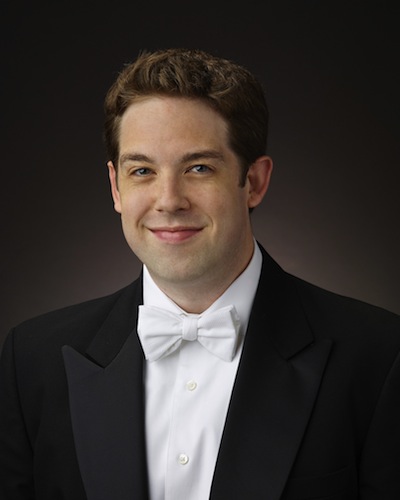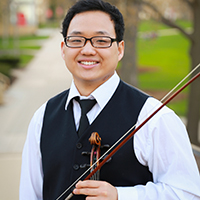Mitchell conducts a vivid program at Texas Music Festival

Brett Mitchell conducted the Texas Music Festival Orchestra Saturday night at the University of Houston’s Moores Opera House.
The Texas Music Festival gives college and conservatory students a glimpse of how professional orchestras work–beginning with making the young instrumentalists tackle a new concert program each week. When an orchestral work springs to life during the weekend’s performance, one can hear the lessons taking hold.
So it was Saturday when conductor Brett Mitchell, the Colorado Symphony’s music director designate, led the 100 players in Edward Elgar’s Enigma Variations in the University of Houston’s Moores Opera House. The orchestra may not consistently boasted the well-blended instrumental choirs and overall lushness of groups whose musicians collaborate year-round. But Elgar’s character sketches of his loved ones came across with vividness and warmth.
Mitchell and the orchestra set the tone immediately. The sound was full and mellow, and Mitchell gave Elgar’s lyricism a natural ebb and flow–which gained ardor when the cellos welled up with their countermelody near the theme’s end. All that established the air of family-and-friends coziness that suffuses the entire work.
From there on, the orchestra’s airiness, gusto and heft made each portrait come alive. The crisp, bustling strings in the second variation conjured up the enthusiasm of Elgar’s amateur-musician pals. Mitchell steered the group adroitly through the fifth variation’s contrasts between sonorous strings and breezy winds. The famous “Nimrod” unfolded naturally and with a supple grace, Mitchell guiding the music to a gradual crescendo of apt nobility.
The orchestra’s lustiness, especially on the part of its brasses and lower strings, captured the bounding energy of the bulldog belonging to the subject of “G.R.S.” At the other extreme, the diaphanous clarinet solo in the “Romanza” evoked feelings whose tenderness is palpable even though their real-life object remains uncertain. And the orchestra built the final variation to a ringing, jubilant close.
Esa-Pekka Salonen’s LA Variations, which opened the concert, wasn’t as well sorted out. Before launching into it, Mitchell talked about the piece and led the orchestra through a few samples. He likened a speedy variation featuring the woodwinds to a Mendelssohn scherzo, and drew a parallel between a variation for unison strings and the music of Wagner and Mahler. But most of those those kinships fell by the wayside in the performance.
The orchestra dug into Salonen’s virtuosic score vigorously, but it sounded like the musicians were working hard. That woodwind variation, rather than suggesting Mendelssohn’s lightness, was more redolent of instrumental lines competing to be heard. In the unison strings’ variation, the growling bass line and clattering percussion almost drowned out the melody. In a dynamic variation that Salonen himself described as the most joyful music he had written, the percussion attacked their parts so aggressively that the result sounded ferocious rather than jubilant.
Each year’s festival includes a young artists competition for the orchestral fellows. As an interlude between Saturday’s sets of variations, the winner of this year’s contest–Matthew Lee, a recent graduate of the University of Wisconsin-Madison–took center stage in the cadenza and finale of Dmitri Shostakovich’s Violin Concerto No. 1.

Matthew Lee
The more vehement the cadenza grew, the more assured and fiery Lee became. The intensity built so quickly that it nearly made up for starting about four-fifths of the way through the concerto. Mitchell and the orchestra picked up on his vehemence when they dug into the finale, and Lee’s agility kept the electricity going. They generated quite a wallop, but the orchestra sometimes complemented Lee with a lightness and bite that revealed the power of quiet dynamism. Salonen’s Variations could have used some of that.


